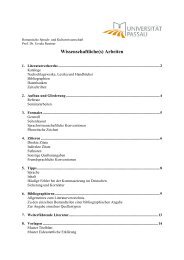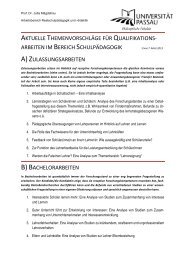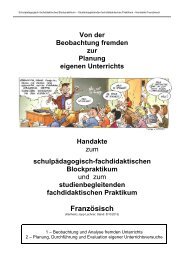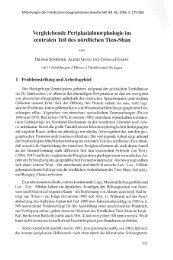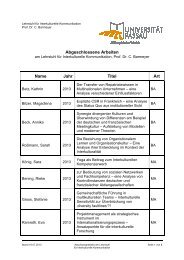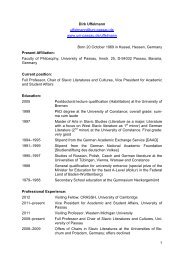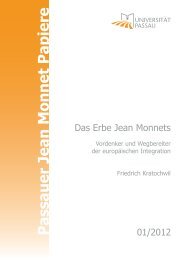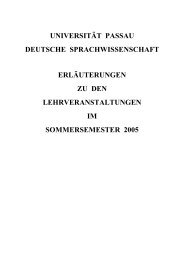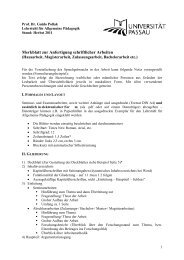The attempt to adopt a mixed-member proportional election system ...
The attempt to adopt a mixed-member proportional election system ...
The attempt to adopt a mixed-member proportional election system ...
Create successful ePaper yourself
Turn your PDF publications into a flip-book with our unique Google optimized e-Paper software.
7<br />
than that of the party-list MPs. It is therefore often described as a “segmented” or “parallel”<br />
<strong>system</strong>. Typical examples in Asia are Japan, South Korea, and Taiwan.<br />
<strong>The</strong> MMP <strong>system</strong>, on the other hand, emphasizes the <strong>proportional</strong> component.<br />
Although there are also two kinds of MPs, the overall distribution of seats in parliament<br />
solely depends on how many votes the political parties received on their party<br />
lists. <strong>The</strong> MPs elected in local constituencies merely add a personalized element <strong>to</strong><br />
this <strong>system</strong>. <strong>The</strong> <strong>to</strong>tal number of MPs a party can claim in parliament depends on its<br />
overall share of votes, making the number of a party’s seats <strong>proportional</strong> <strong>to</strong> its voter<br />
share. If a party’s number of constituency MPs does not reach its <strong>proportional</strong> claim,<br />
the number is filled up from the party list. <strong>The</strong>refore, this <strong>system</strong> is also called “compensa<strong>to</strong>ry”<br />
or “corrective.” Typical examples are Germany and New Zealand (which<br />
essentially copied the German <strong>system</strong> and first applied it in 1996).<br />
According <strong>to</strong> statistics presented in the IDEA’s handbook on Elec<strong>to</strong>ral System<br />
Design, of the 199 countries covered, 91 had a plurality/majority <strong>election</strong> <strong>system</strong>, 72<br />
had a <strong>proportional</strong> <strong>election</strong> <strong>system</strong>, 30 countries had <strong>mixed</strong> <strong>system</strong>s, and six had other<br />
<strong>system</strong>s. Of the 30 countries with <strong>mixed</strong> <strong>system</strong>s, 21 featured parallel <strong>system</strong>s<br />
(MMM), while nine had <strong>adopt</strong>ed MMP. 7 As for recent elec<strong>to</strong>ral change, the handbook<br />
notes,<br />
As Table 1 shows, the trend is rather clear. Most countries [of 27] that<br />
have changed elec<strong>to</strong>ral <strong>system</strong>s have done so in the direction of more <strong>proportional</strong>ity,<br />
either by adding a PR [<strong>proportional</strong> representation] element<br />
<strong>to</strong> a plurality <strong>system</strong> (making it a parallel or MMP <strong>system</strong>) or by completely<br />
replacing their old <strong>system</strong> with List PR. <strong>The</strong> most common switch<br />
has been from a plurality/majority <strong>system</strong> <strong>to</strong> a <strong>mixed</strong> <strong>system</strong>, and there is<br />
not one example of a change in the opposite direction. 8<br />
Locating Thailand in this overall scheme of elec<strong>to</strong>ral <strong>system</strong>s is now easy. “Table 1”<br />
mentioned in the quote lists Thailand as a country that had moved (since the <strong>adopt</strong>ion<br />
of the 1997 constitution) from a plurality/majority <strong>system</strong> (multi-<strong>member</strong> constituencies,<br />
or bloc vote) <strong>to</strong> a <strong>mixed</strong> “parallel” <strong>system</strong> (or MMM). Thailand had thus joined<br />
20 other countries, among them, as mentioned above, Japan, South Korea, and Taiwan.<br />
<strong>The</strong> 1997 constitution had introduced a segregated or parallel <strong>election</strong> <strong>system</strong><br />
(<strong>mixed</strong>-<strong>member</strong> majoritarian, or MMM) with 400 MPs elected in single-<strong>member</strong><br />
constituencies (SMC), complemented by 100 MPs elected in nationwide closed and<br />
blocked party lists. This included a threshold of five percent. That is, only those polit-




